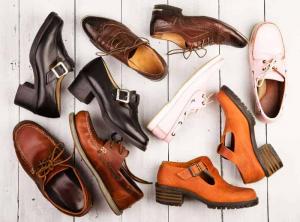BROOKLYN, NY, USA, February 2, 2024 /EINPresswire.com/ — IMARC Group, a leading market research company, has recently releases report titled “Europe Footwear Market Report by Product (Non-Athletic Footwear, Athletic Footwear), Material (Rubber, Leather, Plastic, Fabric, and Others), Distribution Channel (Footwear Specialists, Supermarkets and Hypermarkets, Departmental Stores, Clothing Stores, Online Sales, and Others), Pricing (Premium, Mass), End User (Men, Women, Kids), and Country 2024-2032”. The study provides a detailed analysis of the industry, including the Europe footwear market share, size, trends, and growth forecasts. The report also includes competitor and regional analysis and highlights the latest advancements in the market.
How Big is the Europe Footwear Market?
The Europe footwear market size reached US$ 88.0 Billion in 2023. Looking forward, IMARC Group expects the market to reach US$ 117.2 Billion by 2032, exhibiting a growth rate (CAGR) of 3.14% during 2024-2032.
Request For a PDF Sample Report: https://www.imarcgroup.com/europe-footwear-market/requestsample
Factors Affecting the Growth of the Europe Footwear Industry:
• Consumer Preferences and Fashion Trends:
The European footwear industry is heavily influenced by consumer preferences and evolving fashion trends. Europe, known for its fashion-forward cities like Paris, Milan, and London, often sets global footwear trends. The demand for stylish, innovative designs drives manufacturers to continually update their product offerings. Consumers in Europe are increasingly seeking comfort along with style, leading to the growth of segments like casual and sports footwear. Additionally, there is a rising preference for personalized and unique footwear, which has led to a surge in demand for custom-made and designer shoes. This trend pushes brands to innovate in terms of design, materials, and functionality. The rapid change in fashion trends requires manufacturers to be agile and responsive to consumer needs, directly impacting production cycles and marketing strategies.
• Sustainability and Ethical Production:
Sustainability has become a significant factor in the European footwear industry. Consumers are becoming more environmentally conscious, favoring products that are sustainably produced and have a lower environmental impact. This shift in consumer behavior has led to an increase in the demand for eco-friendly materials like recycled plastics, organic cotton, and sustainably sourced leather. The focus on ethical production also extends to labor practices, with consumers and regulatory bodies in Europe increasingly scrutinizing the working conditions and wages in the footwear manufacturing process. Brands are responding by adopting greener practices, transparent supply chains, and ethical manufacturing standards. This shift not only appeals to the environmentally conscious consumer but also aligns with European regulations that emphasize sustainability and fair labor practices.
• Technological Advancements and Innovation:
Technological advancements play a pivotal role in shaping the European footwear industry. From design and manufacturing to distribution and sales, technology is transforming how footwear is produced and sold. Innovations like 3D printing are allowing for more efficient production processes and customization options. Digitalization and e-commerce platforms are enabling brands to reach a wider audience, facilitating the growth of online retail in the footwear sector. Furthermore, advancements in materials technology are leading to the development of more durable, lightweight, and comfortable footwear. This aspect is particularly significant in the sports and outdoor footwear segments, where performance and comfort are paramount. Technology also enhances supply chain efficiency, helping brands to reduce waste and optimize inventory management, ultimately contributing to a more sustainable and responsive industry.
Europe Footwear Market Report Segmentation:
The report is organized into distinct sections as follows:
Breakup by Product:
• Non-Athletic Footwear
• Athletic Footwear
Non-athletic footwear represents the largest segment in the European market due to its wide consumer appeal, encompassing daily wear, formal, and fashion footwear, catering to diverse age groups and lifestyles.
Breakup by Material:
• Rubber
• Leather
• Plastic
• Fabric
• Others
Leather is the predominant material in European footwear due to its durability, comfort, and long-standing association with quality and luxury in fashion, appealing to a broad consumer base.
Breakup by Distribution Channel:
• Footwear Specialists
• Supermarkets and Hypermarkets
• Departmental Stores
• Clothing Stores
• Online Sales
• Others
Footwear specialists constitute the largest distribution segment in Europe, as they offer a wide variety of brands and styles, providing personalized customer service and expert advice, which is highly valued by European consumers.
Breakup by Pricing:
• Premium
• Mass
The mass segment leads the market in pricing due to the high demand for affordable, fashionable, and functional footwear among a large section of the European population, balancing cost and quality.
Breakup by End User:
• Men
• Women
• Kids
Women represent the largest segment in the European footwear market, driven by a higher propensity for purchasing multiple pairs for different occasions and a strong interest in fashion trends.
Countries Covered:
• Germany
• France
• United Kingdom
• Italy
• Spain
• Others
Germany emerges as the largest market in Europe for footwear, attributable to its large population, strong economy, and high consumer spending power, coupled with a robust retail infrastructure.
Europe Footwear Market Trends:
The market in Europe is primarily driven by the augmenting demand for specialized footwear, driven by growing health consciousness and an active lifestyle trend, leading to an increased interest in sports and outdoor activities. Additionally, the rising levels of disposable income enable consumers to spend more on luxury and high-quality footwear, which is contributing to market expansion.
Moreover, the growing demand for footwear that suits an urban lifestyle, which often requires a blend of comfort, durability, and style and which can be worn for multiple occasions, is propelling market growth. Furthermore, the shifting trend towards more casual and comfortable footwear is driven by changes in work environments (like the increase in remote working), and a focus on leisure and wellness is propelling market growth.
Ask Analyst for Customization and Explore Full Report with TOC & List of Figures: https://www.imarcgroup.com/request?type=report&id=2909&flag=C
Other Key Points Covered in the Report:
• COVID-19 Impact
• Porters Five Forces Analysis
• Value Chain Analysis
• Strategic Recommendations
If you need specific information that is not currently within the scope of the report, we will provide it to you as a part of the customization.
About Us:
IMARC Group is a leading market research company that offers management strategy and market research worldwide. We partner with clients in all sectors and regions to identify their highest-value opportunities, address their most critical challenges, and transform their businesses.
IMARC’s information products include major market, scientific, economic and technological developments for business leaders in pharmaceutical, industrial, and high technology organizations. Market forecasts and industry analysis for biotechnology, advanced materials, pharmaceuticals, food and beverage, travel and tourism, nanotechnology and novel processing methods are at the top of the company’s expertise.
Elena Anderson
IMARC Services Private Limited
+1 631-791-1145
email us here
![]()
Originally published at https://www.einpresswire.com/article/685695782/europe-footwear-market-outlook-industry-size-growth-factors-investment-opportunity-2024-2032





